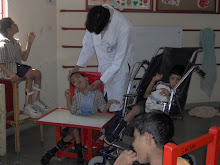The autism spectrum disorders (Childhood autism, Aspergers Disease and Rett's syndrome) can take a huge toll on the caregiver and dentist alike. The energy and time spent in deling with a child with special health care needs can drain even the most patient of us. It is therefore the dream of every parent of an autistic child to be able to find a cure that will calm the child down, and the Gluetein free Casein free diet (GFCF) diet is supposed to do just that.
Historical Background
In the 1960s, Curtis Dohan speculated that the low incidence of schizophrenia in certain South Pacific Island societies was a result of a diet low in wheat and milk-based foods. Dohan proposed a genetic defect wherein individuals are incapable of completely metabolizing gluten andcasein as a possible etiology for schizophrenia. Dohan hypothesized that elevated peptide levels from this incomplete metabolism could be responsible for schizophrenic behaviors.
The possibility of a relationship between autism and the consumption of gluten and casein was first articulated by Kalle Reichelt in 1991.Based on studies showing correlation between autism and increased urinary peptide levels, Reichelt hypothesized that some of these peptides may have an opiate effect. This led to the development of the Opioid Excess Theory, expounded by Paul Shattock and others,which speculates that peptides with opioid activity cross into the bloodstream from the lumen of the intestine, and then into the brain. These peptides were speculated to arise from incomplete digestion of certain foods, in particular gluten from wheat and certain other cereals and from casein from milk and dairy produce. Further work confirmed opioid peptides such as casomorphines (from casein) and gluten exorphines andgliadorphin (from gluten) as possible suspects, due to their chemical similarity to opiates. Reichelt hypothesized that long term exposure to these opiate peptides may have effects on brain maturation and contribute to social awkwardness and isolation. On this basis, Reichelt and others have proposed a gluten-free casein-free (GFCF) diet for sufferers of autism to minimize the buildup of opiate .
Does it Work?
The opinion of the medical world is certainly divided on this issue. While several parents and institutions swear by the efficacy of the GFCF diet, many doctors have remained skeptical of it's efficacy. Research on the diet has been sketchy at best and there are no randomized control trials showing its efficacy. On the contrary it has been argued that the nature of children with autism makes any form of Randomized control difficult if not impossible, and that the positive reactions of thousands of parents cannot be dismissed lightly.
Is it safe?
Whether the diet works or not the far more imporntant issue is one of safety. The only way to implement the GFCF diet is to restrict the intake of milk and milk products in order to eliminate casien (which is a milk protein). Children with Autism have been known to have weaker bones and autistic children who were on GFCF diets have been shown to have significantly lower cortical bone thickness than autistic children who were not. Advocates of the diet aknowledge this fact but attribute it to the fact that a GFCF diet without alternate sources of protein is the problem and not the diet itself.
Implementation of the diet
As mentioned above the GFCF diet involves complete elimination of all sources of glutein such as wheat, rye and barley. The elimination of casien includes the elimination of milk and milk products such as cheese. Whey or curd, however, is said to be acceptable. The traditional Indian food of Curd Rice is therefore a perfect example of GFCF food. Extensive information regarding GFCF diets and their iplementation can be found at www.gfcfdiet.com/
In conclusion
DCSN recognizes the importance of reducing the levels of opiod peptides in autistic children, and acknowledges the ability of the GFCF diet in doing so. But the consquence of removing casien and glutein from the child's diet must be kept in mind and suitable alternatives must be given after discussion with the dietician and/ or the pediatrician.







No comments:
Post a Comment